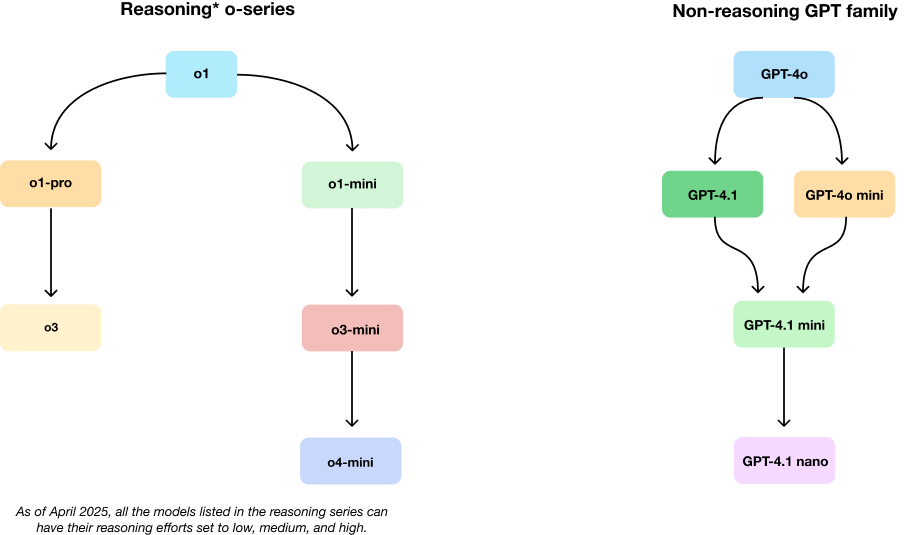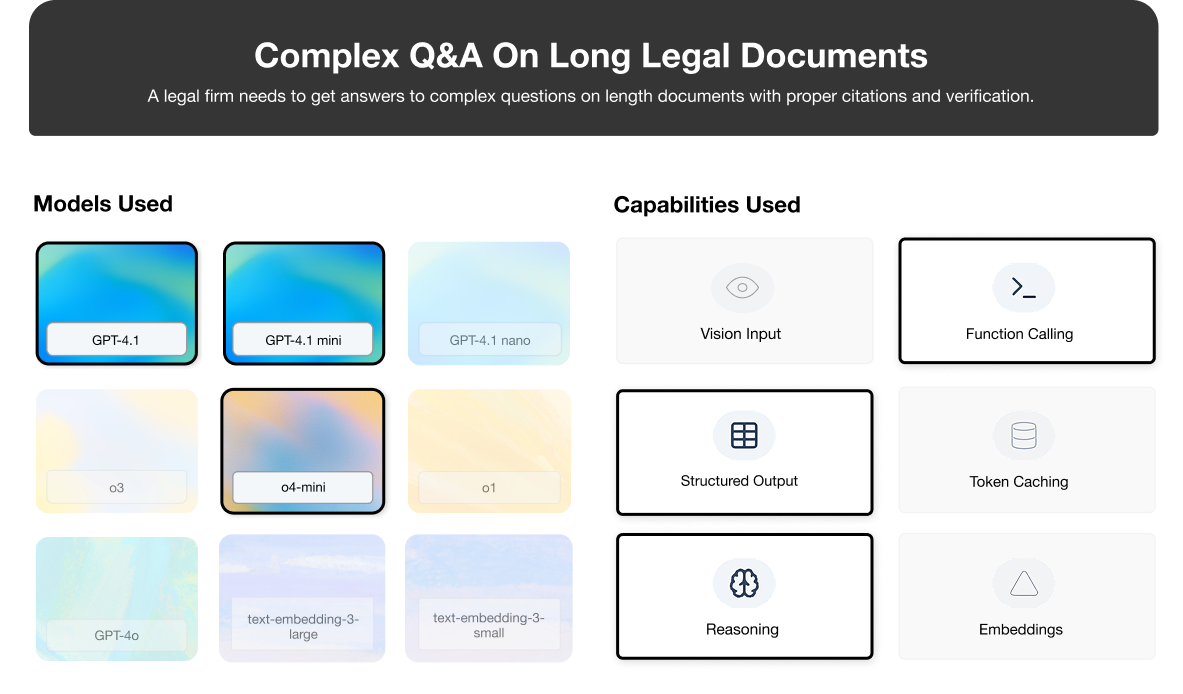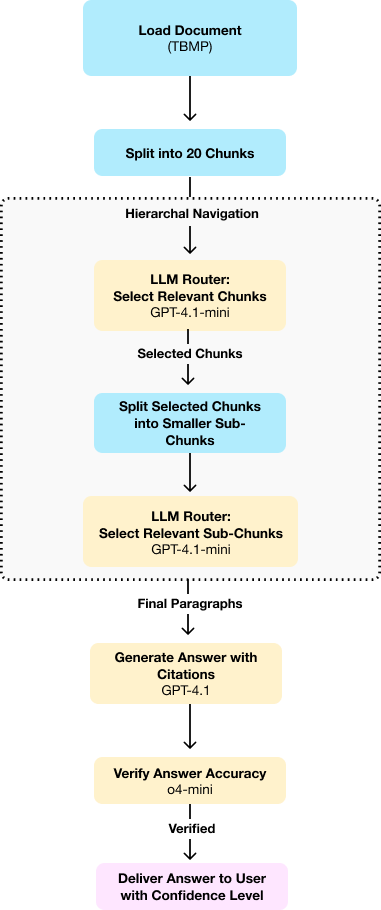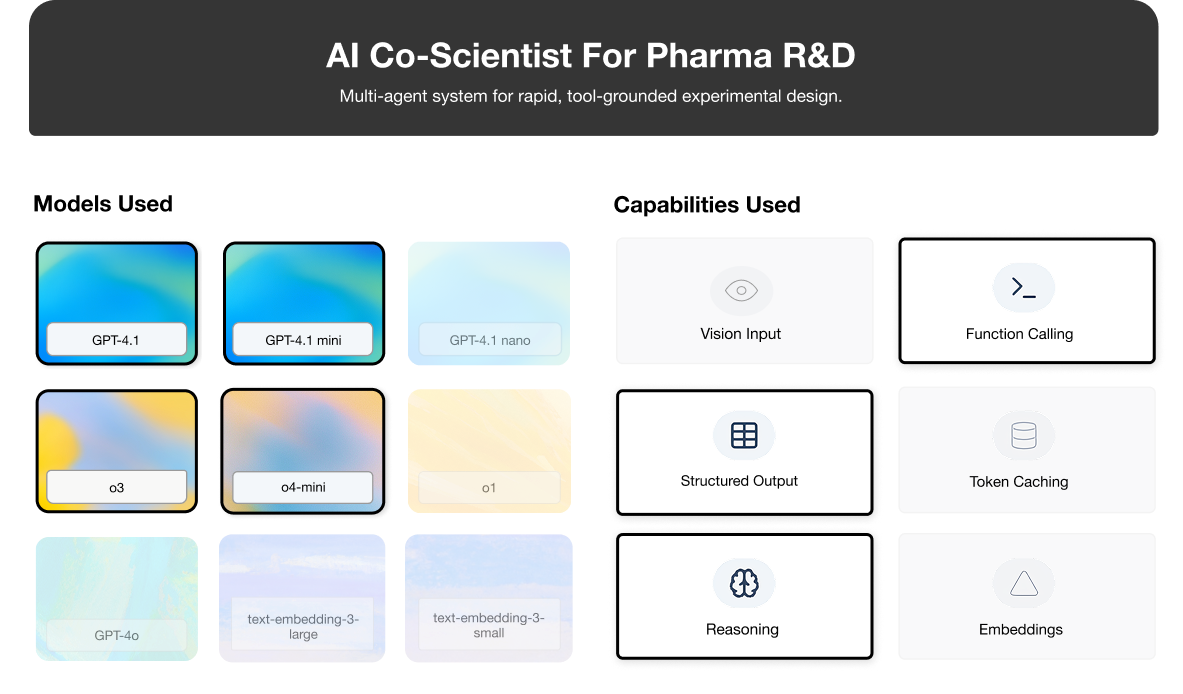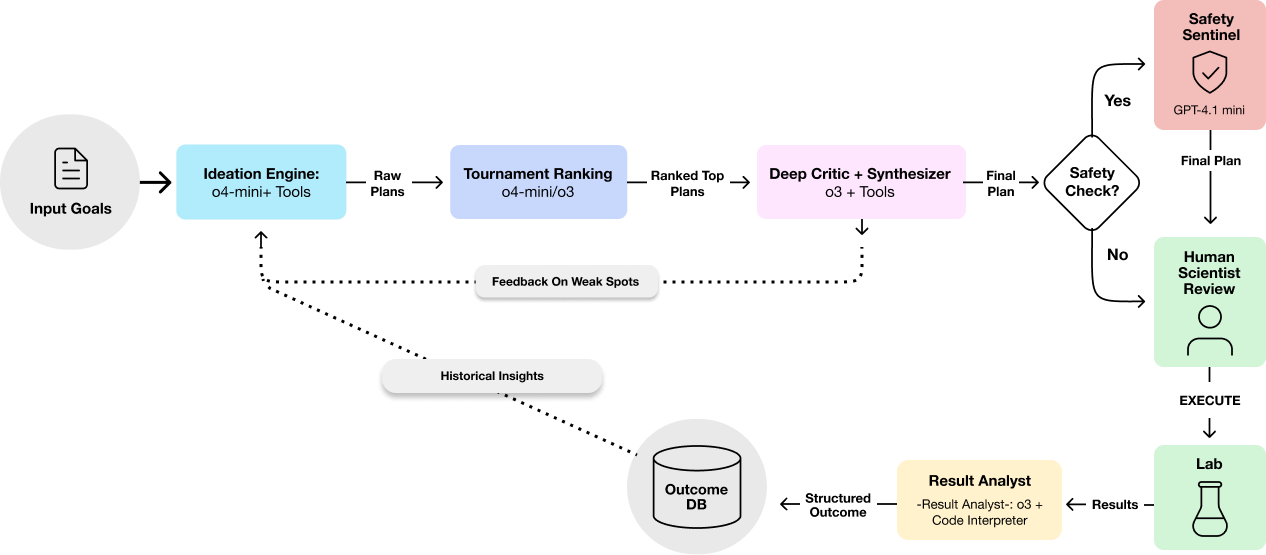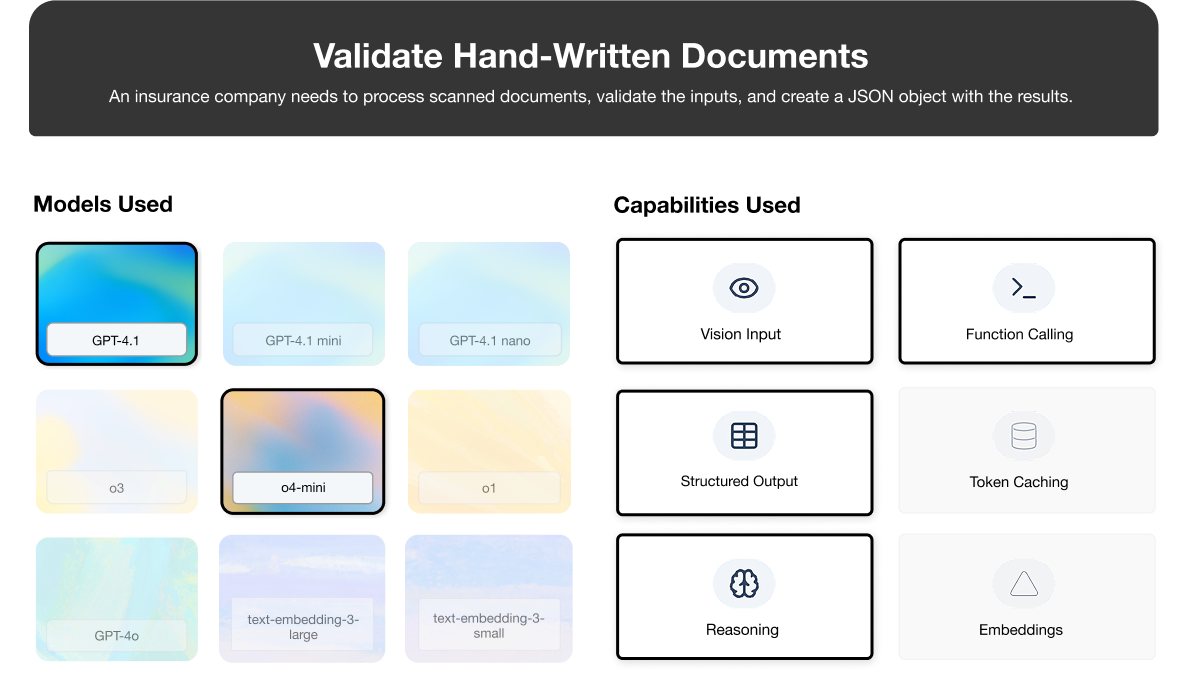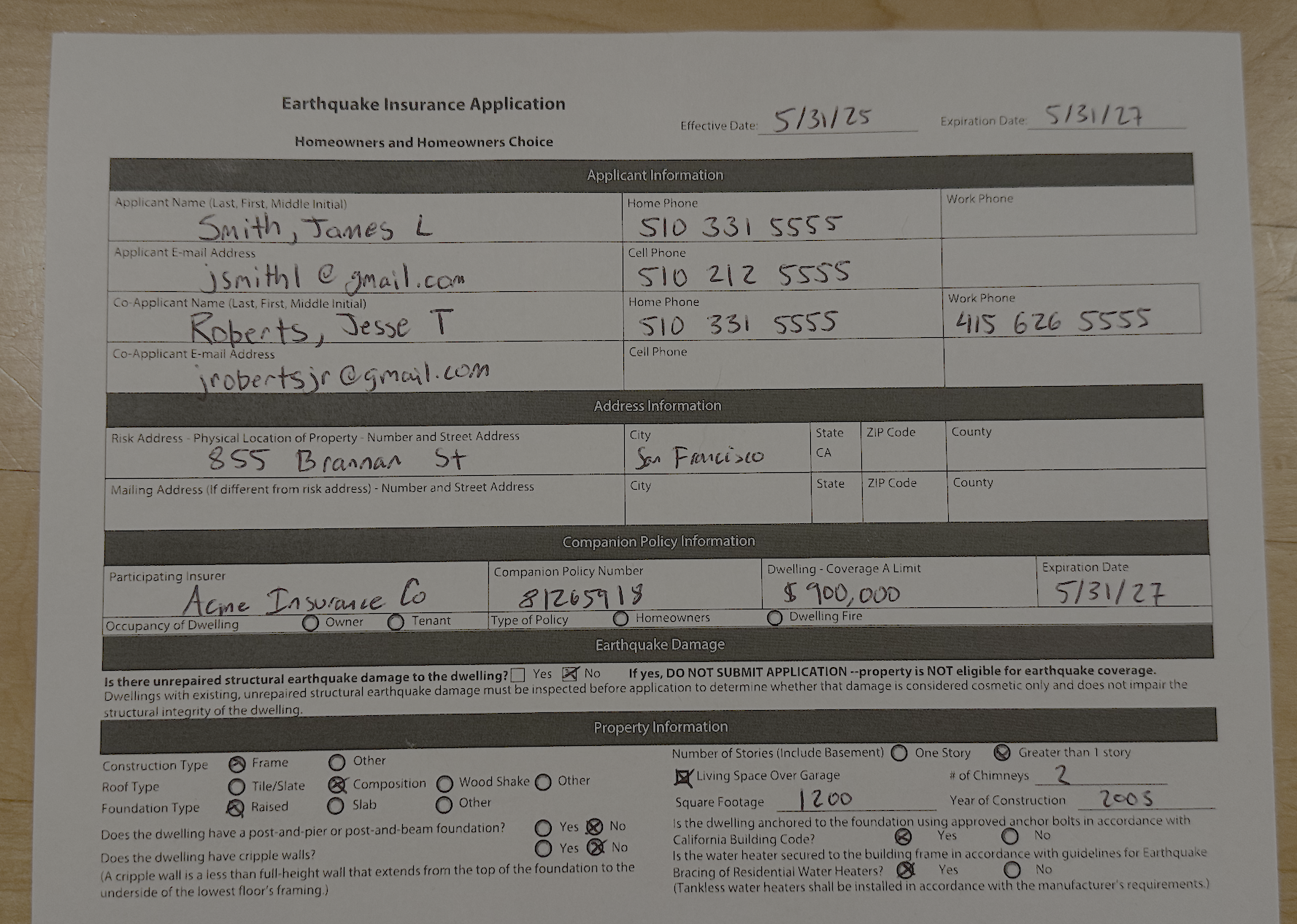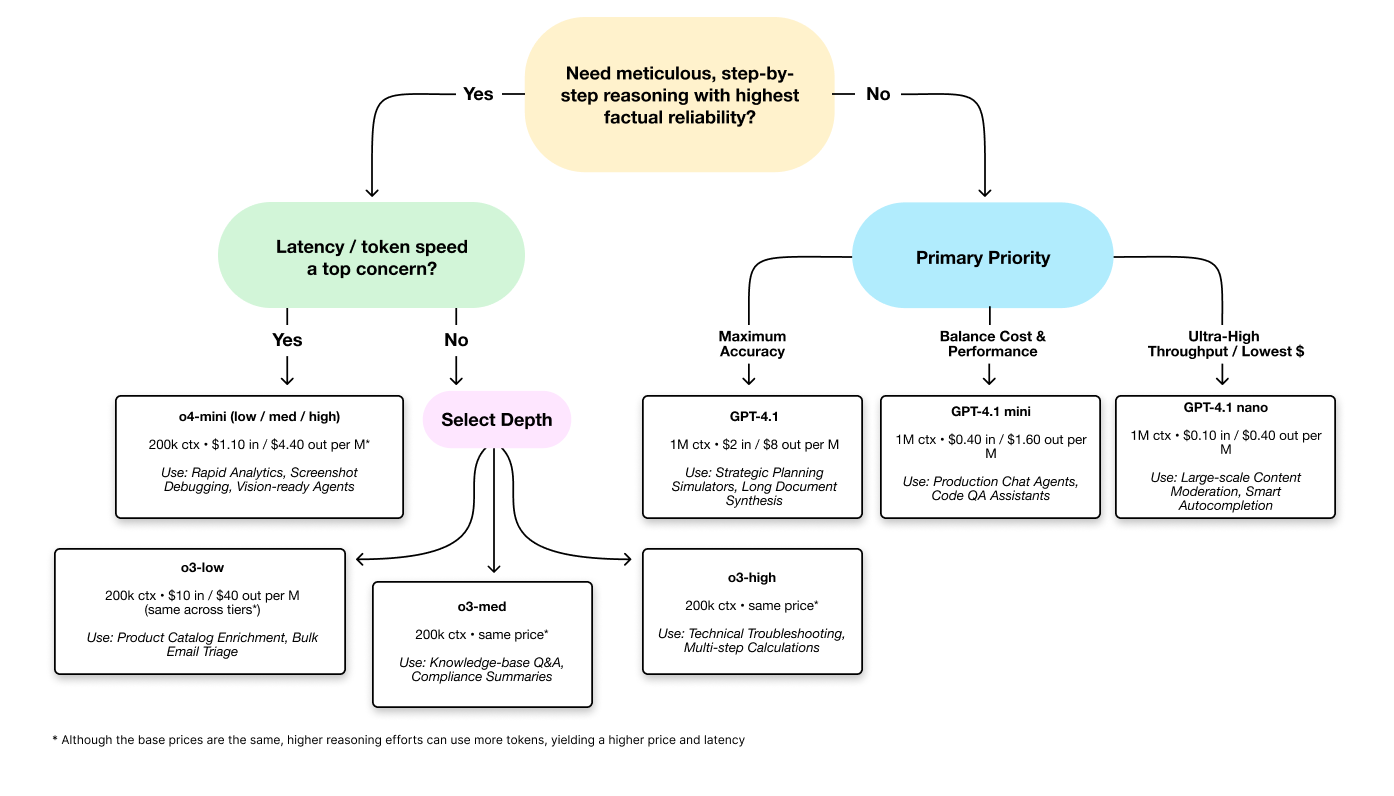Split document into 20 chunks
Chunk 0: 42326 tokens
Chunk 1: 42093 tokens
Chunk 2: 42107 tokens
Chunk 3: 39797 tokens
Chunk 4: 58959 tokens
Chunk 5: 48805 tokens
Chunk 6: 37243 tokens
Chunk 7: 33453 tokens
Chunk 8: 38644 tokens
Chunk 9: 49402 tokens
Chunk 10: 51568 tokens
Chunk 11: 49586 tokens
Chunk 12: 47722 tokens
Chunk 13: 48952 tokens
Chunk 14: 44994 tokens
Chunk 15: 50286 tokens
Chunk 16: 54424 tokens
Chunk 17: 62651 tokens
Chunk 18: 47430 tokens
Chunk 19: 42507 tokens
==== ROUTING AT DEPTH 0 ====
Evaluating 20 chunks for relevance
Selected chunks: 0, 1, 2, 3, 4, 5, 6, 7, 8
Updated scratchpad:
DEPTH 0 REASONING:
The user wants to know the format requirements for filing a motion to compel discovery and how signatures should be handled for such motions.
Based on the evaluation of chunks:
- Chunks 0, 1, 2, 3, 4, 5, 6, 7, 8 are highly relevant since they cover general requirements for submissions, motions, signatures, service, and specifically for motions and discovery in TTAB proceedings.
- These chunks contain detailed info about electronic filing (via ESTTA), paper filing exceptions, signature requirements, service requirements, format of submissions (including motions), timing rules, and professionals' responsibilities.
- Additionally, the rules for motions to compel, including required attachments, timing, and certification of good faith efforts to resolve discovery disputes, are specifically outlined.
- Chunks 11-19 mostly cover post-trial and appeal procedures, less directly relevant.
I will select these relevant chunks to provide a thorough answer about how motions to compel discovery should be filed and how signatures on such motions are handled.
Split document into 20 chunks
Chunk 0: 3539 tokens
Chunk 1: 2232 tokens
Chunk 2: 1746 tokens
Chunk 3: 3078 tokens
Chunk 4: 1649 tokens
Chunk 5: 2779 tokens
Chunk 6: 2176 tokens
Chunk 7: 1667 tokens
Chunk 8: 1950 tokens
Chunk 9: 1730 tokens
Chunk 10: 1590 tokens
Chunk 11: 1964 tokens
Chunk 12: 1459 tokens
Chunk 13: 2070 tokens
Chunk 14: 2422 tokens
Chunk 15: 1976 tokens
Chunk 16: 2335 tokens
Chunk 17: 2694 tokens
Chunk 18: 2282 tokens
Chunk 19: 982 tokens
Split document into 20 chunks
Chunk 0: 2880 tokens
Chunk 1: 1323 tokens
Chunk 2: 2088 tokens
Chunk 3: 1493 tokens
Chunk 4: 2466 tokens
Chunk 5: 2563 tokens
Chunk 6: 2981 tokens
Chunk 7: 2723 tokens
Chunk 8: 2264 tokens
Chunk 9: 1900 tokens
Chunk 10: 2134 tokens
Chunk 11: 1778 tokens
Chunk 12: 2484 tokens
Chunk 13: 1922 tokens
Chunk 14: 2237 tokens
Chunk 15: 2044 tokens
Chunk 16: 2097 tokens
Chunk 17: 1326 tokens
Chunk 18: 2427 tokens
Chunk 19: 962 tokens
Split document into 20 chunks
Chunk 0: 2341 tokens
Chunk 1: 1724 tokens
Chunk 2: 2042 tokens
Chunk 3: 3225 tokens
Chunk 4: 1617 tokens
Chunk 5: 2247 tokens
Chunk 6: 1741 tokens
Chunk 7: 1914 tokens
Chunk 8: 2027 tokens
Chunk 9: 2596 tokens
Chunk 10: 2366 tokens
Chunk 11: 2164 tokens
Chunk 12: 2471 tokens
Chunk 13: 1821 tokens
Chunk 14: 1496 tokens
Chunk 15: 1712 tokens
Chunk 16: 1909 tokens
Chunk 17: 1961 tokens
Chunk 18: 2309 tokens
Chunk 19: 2419 tokens
Split document into 20 chunks
Chunk 0: 2304 tokens
Chunk 1: 2140 tokens
Chunk 2: 1845 tokens
Chunk 3: 3053 tokens
Chunk 4: 2008 tokens
Chunk 5: 2052 tokens
Chunk 6: 2240 tokens
Chunk 7: 1943 tokens
Chunk 8: 1732 tokens
Chunk 9: 1507 tokens
Chunk 10: 1453 tokens
Chunk 11: 1976 tokens
Chunk 12: 1871 tokens
Chunk 13: 1620 tokens
Chunk 14: 1906 tokens
Chunk 15: 1558 tokens
Chunk 16: 1889 tokens
Chunk 17: 2233 tokens
Chunk 18: 2208 tokens
Chunk 19: 2259 tokens
Split document into 20 chunks
Chunk 0: 4620 tokens
Chunk 1: 3446 tokens
Chunk 2: 1660 tokens
Chunk 3: 3203 tokens
Chunk 4: 4373 tokens
Chunk 5: 4233 tokens
Chunk 6: 3651 tokens
Chunk 7: 3820 tokens
Chunk 8: 3018 tokens
Chunk 9: 3018 tokens
Chunk 10: 4201 tokens
Chunk 11: 3043 tokens
Chunk 12: 2438 tokens
Chunk 13: 3295 tokens
Chunk 14: 2578 tokens
Chunk 15: 2423 tokens
Chunk 16: 1386 tokens
Chunk 17: 1482 tokens
Chunk 18: 1615 tokens
Chunk 19: 1454 tokens
Split document into 20 chunks
Chunk 0: 1468 tokens
Chunk 1: 1946 tokens
Chunk 2: 2020 tokens
Chunk 3: 3384 tokens
Chunk 4: 2458 tokens
Chunk 5: 3535 tokens
Chunk 6: 3059 tokens
Chunk 7: 2027 tokens
Chunk 8: 2417 tokens
Chunk 9: 2772 tokens
Chunk 10: 1913 tokens
Chunk 11: 2674 tokens
Chunk 12: 2131 tokens
Chunk 13: 1409 tokens
Chunk 14: 3256 tokens
Chunk 15: 2827 tokens
Chunk 16: 2547 tokens
Chunk 17: 4187 tokens
Chunk 18: 1527 tokens
Chunk 19: 1246 tokens
Split document into 20 chunks
Chunk 0: 1272 tokens
Chunk 1: 1646 tokens
Chunk 2: 1643 tokens
Chunk 3: 2279 tokens
Chunk 4: 1451 tokens
Chunk 5: 1635 tokens
Chunk 6: 1983 tokens
Chunk 7: 1337 tokens
Chunk 8: 1820 tokens
Chunk 9: 2269 tokens
Chunk 10: 2894 tokens
Chunk 11: 2176 tokens
Chunk 12: 1401 tokens
Chunk 13: 1882 tokens
Chunk 14: 2114 tokens
Chunk 15: 2240 tokens
Chunk 16: 1900 tokens
Chunk 17: 1550 tokens
Chunk 18: 1713 tokens
Chunk 19: 2035 tokens
Split document into 20 chunks
Chunk 0: 2694 tokens
Chunk 1: 1808 tokens
Chunk 2: 1874 tokens
Chunk 3: 1328 tokens
Chunk 4: 1552 tokens
Chunk 5: 1436 tokens
Chunk 6: 1367 tokens
Chunk 7: 1333 tokens
Chunk 8: 978 tokens
Chunk 9: 1303 tokens
Chunk 10: 1738 tokens
Chunk 11: 1509 tokens
Chunk 12: 1875 tokens
Chunk 13: 1524 tokens
Chunk 14: 1597 tokens
Chunk 15: 1807 tokens
Chunk 16: 2449 tokens
Chunk 17: 2271 tokens
Chunk 18: 1467 tokens
Chunk 19: 1540 tokens
Split document into 20 chunks
Chunk 0: 1597 tokens
Chunk 1: 1554 tokens
Chunk 2: 1685 tokens
Chunk 3: 1416 tokens
Chunk 4: 1702 tokens
Chunk 5: 1575 tokens
Chunk 6: 1842 tokens
Chunk 7: 1981 tokens
Chunk 8: 1393 tokens
Chunk 9: 1562 tokens
Chunk 10: 1569 tokens
Chunk 11: 1898 tokens
Chunk 12: 3186 tokens
Chunk 13: 2337 tokens
Chunk 14: 1889 tokens
Chunk 15: 1948 tokens
Chunk 16: 1628 tokens
Chunk 17: 3544 tokens
Chunk 18: 2454 tokens
Chunk 19: 1882 tokens
==== ROUTING AT DEPTH 1 ====
Evaluating 180 chunks for relevance
Selected chunks: 5, 6, 7, 17, 18, 19, 20, 400, 401, 408, 410
Updated scratchpad:
DEPTH 0 REASONING:
The user wants to know the format requirements for filing a motion to compel discovery and how signatures should be handled for such motions.
Based on the evaluation of chunks:
- Chunks 0, 1, 2, 3, 4, 5, 6, 7, 8 are highly relevant since they cover general requirements for submissions, motions, signatures, service, and specifically for motions and discovery in TTAB proceedings.
- These chunks contain detailed info about electronic filing (via ESTTA), paper filing exceptions, signature requirements, service requirements, format of submissions (including motions), timing rules, and professionals' responsibilities.
- Additionally, the rules for motions to compel, including required attachments, timing, and certification of good faith efforts to resolve discovery disputes, are specifically outlined.
- Chunks 11-19 mostly cover post-trial and appeal procedures, less directly relevant.
I will select these relevant chunks to provide a thorough answer about how motions to compel discovery should be filed and how signatures on such motions are handled.
DEPTH 1 REASONING:
The user's question asks about the format requirements for filing a motion to compel discovery and how signatures should be handled. Relevant information will likely involve sections on "motions" specifically "motion to compel discovery," filing format, signature requirements, and related procedural rules in TTAB practice.
Based on the large amount and depth of the provided chunks, I identified the following relevant topics and chunks addressing them:
1. Signature Requirements & Acceptable Formats for Motions and Submissions
- Detailed rules for signatures on submissions including motions are in chunks 5, 6, 7.
- These include rules on electronic filing, use of ESTTA, required signature format including electronic signatures with the symbol method "/sig/".
2. Format of Submissions and Use of ESTTA
- Filing requirements, printing format, size, paper submissions, and special exceptions are found in chunks 7, 8, 9, 10, 11, 12, 13.
- Motions generally must be filed via ESTTA, with exceptions requiring petitions to Director with reasons.
3. Motions to Compel and Discovery Motions
- Specific rules related to filing motions such as motions to compel discovery, service, and timing are expected in the portions covering discovery and motions.
- Discovery and related motions are introduced in chapters starting from chunk 400 and beyond.
4. Service and Certificates of Service
- How motions must be served and proof of service with certificates is discussed in chunks 17, 18, 19, 20.
- These include requirements that every submission in inter partes cases, except notice of opposition or petition to cancel, must be served on adversary and proof of service provided.
5. Motions to Compel Discovery Details
- Discovery and motion procedure, filing format, timing, service, and related sanctions are extensively covered in chunks 400 and following.
- These include disclosures, discovery conferences, timing for discovery requests, responses, motions to compel, and sanctions.
From the above, the following chunks are most likely to provide the requested information:
- Chunks 5, 6, 7: Signature rules and filing format including motions.
- Chunks 17, 18, 19, 20: Service of submissions and certificates of service.
- Chunks 400 to 410 plus related portions (401.01, 401.02, 401.03, 408, 410): Discovery rules, motions to compel details.
These cover the format of motions including motions to compel discovery, signature rules, service and proof of service, and discovery procedure and rules governing motions.
Less relevant chunks to the question are routine procedural provisions on oppositions, petitions to cancel, answers, which do not specifically address filing or signatures of motions to compel discovery.
Plan: Select the above relevant chunks and report key procedural points on the format in which a motion to compel discovery must be filed and how signatures must be handled.
Split document into 8 chunks
Chunk 0: 398 tokens
Chunk 1: 256 tokens
Chunk 2: 389 tokens
Chunk 3: 356 tokens
Chunk 4: 401 tokens
Chunk 5: 277 tokens
Chunk 6: 435 tokens
Chunk 7: 265 tokens
Split document into 6 chunks
Chunk 0: 353 tokens
Chunk 1: 393 tokens
Chunk 2: 388 tokens
Chunk 3: 398 tokens
Chunk 4: 397 tokens
Chunk 5: 247 tokens
Split document into 5 chunks
Chunk 0: 325 tokens
Chunk 1: 389 tokens
Chunk 2: 303 tokens
Chunk 3: 344 tokens
Chunk 4: 306 tokens
Split document into 8 chunks
Chunk 0: 396 tokens
Chunk 1: 354 tokens
Chunk 2: 361 tokens
Chunk 3: 378 tokens
Chunk 4: 388 tokens
Chunk 5: 394 tokens
Chunk 6: 361 tokens
Chunk 7: 61 tokens
Split document into 7 chunks
Chunk 0: 396 tokens
Chunk 1: 355 tokens
Chunk 2: 377 tokens
Chunk 3: 362 tokens
Chunk 4: 326 tokens
Chunk 5: 397 tokens
Chunk 6: 69 tokens
Split document into 3 chunks
Chunk 0: 388 tokens
Chunk 1: 373 tokens
Chunk 2: 221 tokens
Split document into 8 chunks
Chunk 0: 360 tokens
Chunk 1: 314 tokens
Chunk 2: 369 tokens
Chunk 3: 363 tokens
Chunk 4: 361 tokens
Chunk 5: 393 tokens
Chunk 6: 361 tokens
Chunk 7: 358 tokens
==== ROUTING AT DEPTH 2 ====
Evaluating 45 chunks for relevance
Selected chunks: 0, 4, 5, 6, 7, 8, 9, 10, 11, 12, 15, 16, 17, 18, 23, 24, 25, 26, 27, 28, 29, 30, 31, 32, 33, 34, 35, 36
Updated scratchpad:
DEPTH 0 REASONING:
The user wants to know the format requirements for filing a motion to compel discovery and how signatures should be handled for such motions.
Based on the evaluation of chunks:
- Chunks 0, 1, 2, 3, 4, 5, 6, 7, 8 are highly relevant since they cover general requirements for submissions, motions, signatures, service, and specifically for motions and discovery in TTAB proceedings.
- These chunks contain detailed info about electronic filing (via ESTTA), paper filing exceptions, signature requirements, service requirements, format of submissions (including motions), timing rules, and professionals' responsibilities.
- Additionally, the rules for motions to compel, including required attachments, timing, and certification of good faith efforts to resolve discovery disputes, are specifically outlined.
- Chunks 11-19 mostly cover post-trial and appeal procedures, less directly relevant.
I will select these relevant chunks to provide a thorough answer about how motions to compel discovery should be filed and how signatures on such motions are handled.
DEPTH 1 REASONING:
The user's question asks about the format requirements for filing a motion to compel discovery and how signatures should be handled. Relevant information will likely involve sections on "motions" specifically "motion to compel discovery," filing format, signature requirements, and related procedural rules in TTAB practice.
Based on the large amount and depth of the provided chunks, I identified the following relevant topics and chunks addressing them:
1. Signature Requirements & Acceptable Formats for Motions and Submissions
- Detailed rules for signatures on submissions including motions are in chunks 5, 6, 7.
- These include rules on electronic filing, use of ESTTA, required signature format including electronic signatures with the symbol method "/sig/".
2. Format of Submissions and Use of ESTTA
- Filing requirements, printing format, size, paper submissions, and special exceptions are found in chunks 7, 8, 9, 10, 11, 12, 13.
- Motions generally must be filed via ESTTA, with exceptions requiring petitions to Director with reasons.
3. Motions to Compel and Discovery Motions
- Specific rules related to filing motions such as motions to compel discovery, service, and timing are expected in the portions covering discovery and motions.
- Discovery and related motions are introduced in chapters starting from chunk 400 and beyond.
4. Service and Certificates of Service
- How motions must be served and proof of service with certificates is discussed in chunks 17, 18, 19, 20.
- These include requirements that every submission in inter partes cases, except notice of opposition or petition to cancel, must be served on adversary and proof of service provided.
5. Motions to Compel Discovery Details
- Discovery and motion procedure, filing format, timing, service, and related sanctions are extensively covered in chunks 400 and following.
- These include disclosures, discovery conferences, timing for discovery requests, responses, motions to compel, and sanctions.
From the above, the following chunks are most likely to provide the requested information:
- Chunks 5, 6, 7: Signature rules and filing format including motions.
- Chunks 17, 18, 19, 20: Service of submissions and certificates of service.
- Chunks 400 to 410 plus related portions (401.01, 401.02, 401.03, 408, 410): Discovery rules, motions to compel details.
These cover the format of motions including motions to compel discovery, signature rules, service and proof of service, and discovery procedure and rules governing motions.
Less relevant chunks to the question are routine procedural provisions on oppositions, petitions to cancel, answers, which do not specifically address filing or signatures of motions to compel discovery.
Plan: Select the above relevant chunks and report key procedural points on the format in which a motion to compel discovery must be filed and how signatures must be handled.
DEPTH 2 REASONING:
The user's question is about the format for filing a motion to compel discovery and handling of signatures. Relevant information is likely contained in sections addressing motions, discovery procedures, submission format, signature requirements, and service rules.
Chunks covering signature requirements (5-12) provide detailed rules on legal signatures, electronic signatures, who must sign (attorneys or parties with legal authority), and signature content.
Chunks 0, 4, 7-10, 15-18 discuss the required format for submissions, including motions, the mandate to file electronically via ESTTA, and exceptions for paper filings.
Chunks 23-35 address service of submissions, including requirements for service on all parties, methods of service, and certificates of service.
Finally, discovery-related motions such as motions to compel discovery and their filing details should be in chunks from 400 onwards (although these aren't fully visible here, the rationale included these chunks as likely relevant).
Therefore, chunks 0,4,5,6,7,8,9,10,11,12,15,16,17,18,23,24,25,26,27,28,29,30,31,32,33,34,35,36 are selected as most relevant to provide a thorough answer on the filing format and signatures for a motion to compel discovery.
Returning 28 relevant chunks at depth 2
==== FIRST 3 RETRIEVED PARAGRAPHS ====
PARAGRAPH 1 (ID: 0.0.5.0):
----------------------------------------
104 Business to be Conducted in Writing
37 C.F.R. § 2.190(b) Electronic trademark documents. … Documents that r elate to proceedings before
the Trademark Trial and Appeal Board must be filed electronically with the Board through ESTTA. 37 C.F.R. § 2.191 Action of the Office based on the written record. All business with the Office must be
transacted in writing. The action of the Office will be based exclusively on the written record. No consideration
will be given to any alleged oral promise, stipulation, or understanding when there is disagreement or doubt. With the exceptions of discovery conferences with Board participation, see TBMP § 401.01, and telephone
conferences, see TBMP § 413.01 and TBMP § 502.06, all business with the Board should be transacted in
writing. 37 C.F.R. § 2.191 . The personal attendance of parties or their attorne ys or other authorized
representatives at the offices of the Board is unnecessary , except in the case of a pretrial conference as
provided in 37 C.F.R. § 2.120(j), or upon oral argument at final hearing, if a party so desires, as pro vided
in 37 C.F.R. § 2.129. Decisions of the Board will be based exclusively on the written record before it. [Note
1.] Documents filed in proceedings before the Board must be filed through ESTT A. 37 C.F.R. § 2.190(b). See TBMP § 110.01(a). Board proceedings are conducted in English. If a party intends to rely upon an y submissions that are in a
language other than English, the party should also file a translation of the submissions. If a translation is
not filed, the submissions may not be considered. [Note 2.] NOTES:
1. Cf.
----------------------------------------
PARAGRAPH 2 (ID: 0.0.5.4):
----------------------------------------
The document should
also include a title describing its nature, e.g., “Notice of Opposition,” “Answer,” “Motion to Compel,” “Brief
in Opposition to Respondent’s Motion for Summary Judgment,” or “Notice of Reliance.”
Documents filed in an application which is the subject of an inter partes proceeding before the Board should
be filed with the Board, not the Trademark Operation, and should bear at the top of the first page both the
application serial number, and the inter partes proceeding number and caption. Similarly , requests under
Trademark Act § 7, 15 U.S.C. § 1057, to amend, correct, or surrender a registration which is the subject of
a Board inter partes proceeding, and any new power of attorney, designation of domestic representative, or
change of address submitted in connection with such a registration, should be filed with the Board, not with
the Trademark Operation, and should bear at the top of its first page the re gistration number, and the inter
partes proceeding number and the proceeding caption. [Note 2.] 100-14June 2024
TRADEMARK TRIAL AND APPEAL BOARD MANUAL OF PROCEDURE§ 105
NOTES:
1. 37 C.F.R. § 2.194. 2. 37 C.F.R. § 2.194. 106.02 Signature of Submissions
37 C.F.R. § 2.119(e) Every submission filed in an inter partes proceeding, and every request for an extension
of time to file an opposition, must be signed by the party filing it, or by the party’s attorney or other authorized
representative, but an unsigned submission will not be r efused consideration if a signed copy is submitted
to the Office within the time limit set in the notification of this defect by the Office. 37 C.F.R. § 11.14(e) Appearance.
----------------------------------------
PARAGRAPH 3 (ID: 0.0.5.5):
----------------------------------------
No individual other than those specified in par agraphs (a), (b), and (c)
of this section will be permitted to pr actice before the Office in tr ademark matters on behalf of a client. Except as specified in § 2.11(a) of this chapter, an individual may appear in a trademark or other non-patent
matter in his or her own behalf or on behalf of:
(1) A firm of which he or she is a member;
(2) A partnership of which he or she is a partner; or
(3) A corporation or association of which he or she is an officer and which he or she is authorized to
represent. 37 C.F.R. § 11.18 Signature and certificate for correspondence filed in the Office. (a) For all documents filed in the Office in patent, trademark, and other non-patent matters, and all
documents filed with a hearing officer in a disciplinary proceeding, except for correspondence that is
required to be signed by the applicant or party, each piece of correspondence filed by a practitioner in the
Office must bear a signature, personally signed or inserted by such practitioner, in compliance with §
1.4(d)(1), § 1.4(d)(2), or § 2.193(a) of this chapter.
----------------------------------------
